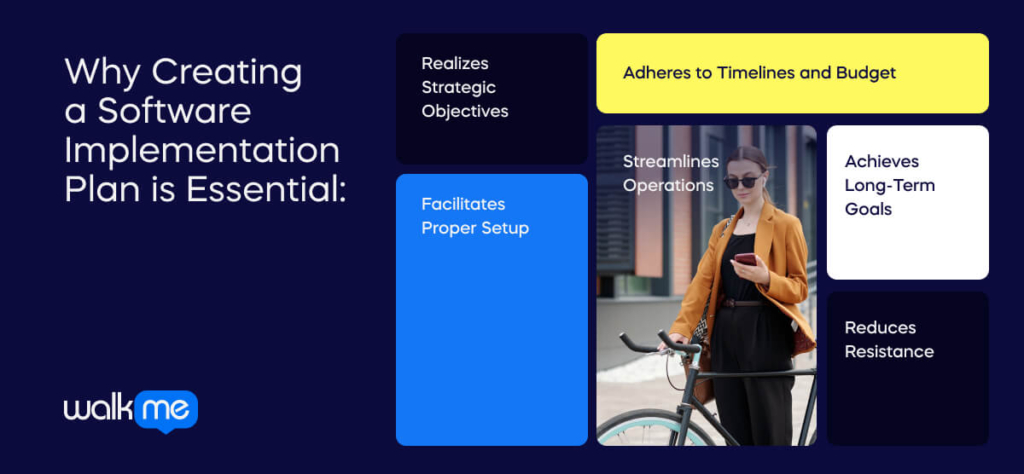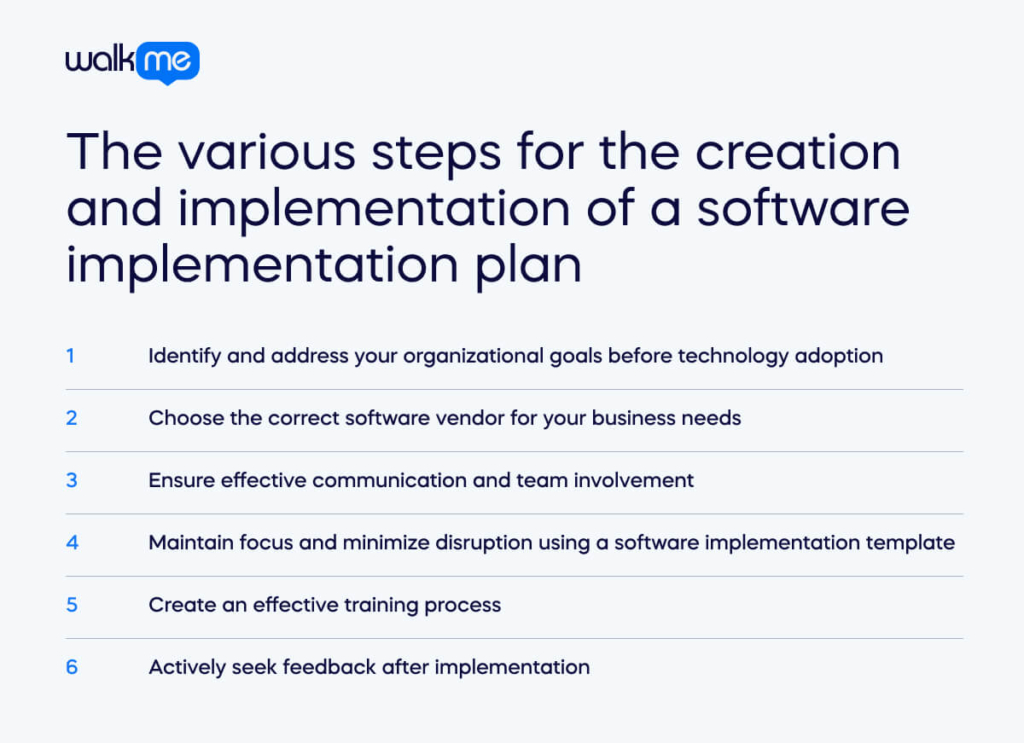Technology adoption for an enterprise can be like navigating a lengthy, unpredictable roller coaster involving significant financial and resource investments.
Whether your organization is investing in its first ERP, CRM, or HR software or transitioning from an outdated legacy system that no longer fits your needs, grasping the timeline for software implementation is crucial for effective planning.
A structured software implementation plan can catalyze growth and cost savings for your company, enhancing process efficiency, whereas a disorganized approach may result in financial losses and operational interruptions.
More importantly, a successful software implementation plan can help you reduce resistance to change as it encourages you to collaborate with employees on its adoption.
This article will go through what software implementation is and underline its significance. Additionally, it will introduce some tools that can aid in devising a software implementation plan and provide a step-by-step guide to software change implementation.
What is a software implementation plan?
A software implementation plan is essential for identifying and integrating the ideal software solution to meet your business requirements.
The digital adoption process requires a major investment in time and resources, including financial and personnel costs. Lacking a pre-established plan could significantly increase the risk of failure in adopting new software.
By having a well-crafted plan, your company can prevent rushed decisions, guarantee the involvement of the right team members, ensure proper system configuration, and foster an environment where employees can fully realize the advantages of the new software.
This approach also includes providing comprehensive training to ensure successful implementation.
Why is creating a software implementation plan essential?

A software implementation plan is crucial as it effectively realizes your strategic objectives without excessive expenditure of materials and human resources. It facilitates the proper setup of the system, ensuring the involvement of individuals with the requisite expertise throughout the process.
This plan ensures that your team adheres to the projected timelines and budget, streamlining operations. Additionally, it aids in clearly distributing roles and responsibilities within the team, preventing the overlap of tasks and reducing the time spent on decision-making.
Furthermore, a software implementation process is instrumental in helping your company achieve its long-term goals by adopting new software for valid reasons rather than merely following industry trends. It also emphasizes the importance of clearly communicating the software’s benefits, thereby reducing, if not eliminating, any resistance to its adoption.
Step-by-step instructions for creating and implementing a software implementation plan

Developing a software implementation plan necessitates a particular approach.
To assist you, here are a series of software implementation tips designed to guide you in formulating an effective plan:
Identify and address your organizational goals before technology adoption
The initial step in a successful software implementation strategy involves deep diving into the organization’s challenges and areas that require improvement. Engaging with staff and other stakeholders to gather insights is crucial.
If the analysis reveals critical issues such as low organizational efficiency or revenue loss, these should become the focus areas for the software solution. This technology alignment with business objectives is foundational to the implementation’s success.
Having identified the core challenges, the next step is to propose specific solutions. This could involve detailing how a new procurement system or project management tool could enhance employee productivity and efficiency, directly tackling the pain points uncovered.
The solution should not only be a fit for the present needs but also scalable to accommodate future growth.
Justifying the investment in new software also requires a comprehensive cost-benefit analysis. This analysis should encompass tangible and intangible aspects, measuring the direct financial costs against the broader benefits, including improved efficiency, to validate the implementation plan.
Lastly, developing a precise timeline is essential for managing expectations around the software evaluation, implementation, and realizing returns on investment. Including development and testing phases in your implementation plan ensures a smooth transition.
Choose the correct software vendor for your business needs
Choosing a software vendor is pivotal, demanding meticulous evaluation of various aspects. It involves assessing the software’s functionalities and determining whether the solution is cloud-based, on-premises, hybrid, or both.
The decision also hinges on the vendor’s proven reliability and track record, which can be evaluated through their experience and customer feedback.
Furthermore, the scalability of the software and its compatibility with current systems are crucial considerations.
Lastly, the quality and availability of customer support and employee training play a significant role, especially in understanding if these services are covered within the implementation expenses.
Ensure effective communication and team involvement
Assigning team owners for different aspects of the software implementation ensures that responsibilities are clearly defined.
This software implementation team should understand how the software will be utilized across various departments and anticipate potential challenges. This approach facilitates smooth implementation and supports change management. This is done by involving representatives from across the organization.
Maintain focus and minimize disruption using a software implementation template
Avoiding scope creep, one of the many software implementation challenges, is crucial to keep your employees on track with the digital change.
A focused needs document can guide the evaluation process, preventing the project from expanding beyond its original scope, which could lead to increased costs and delays.
A software implementation plan template assists in defining the project’s scope, objectives, and deliverables while also helping to establish a timeline and effectively allocate resources.
It aids in identifying potential risks and formulating strategies to mitigate them. Additionally, it ensures clear communication and alignment among stakeholders, streamlines the implementation process to minimize disruptions, and offers a framework for assessing the project’s success.
Moreover, the template facilitates cross-functional collaboration and coordination among team members, increasing transparency and accountability throughout the project.
Create an effective training process
A parallel process of developing comprehensive onboarding and training programs is vital to prepare the team for the new software.
Training should be rolled out systematically, ensuring each team understands how to use the software efficiently within their specific workflows. This preparation is vital to minimizing downtime and maximizing the software’s benefits from day one.
Actively seek feedback after implementation
Establish an employee feedback loop to identify and address any issues early. Use surveys to gather user experiences and maintain an open line of communication for support and issue resolution, ensuring a trusted email service for secure feedback collection.
Software implementation plan challenges
A well-executed software implementation plan boosts productivity, cuts costs, enhances customer experiences, and boosts profitability.
Yet, challenges can impede its success. These are:
Lack of a training program or schedule
Introducing new software without giving your team the essential skills to use effectively is a recipe for disaster. Proper training ensures the software is fully utilized, minimizing errors and inefficiencies.
Utilizing diverse training methods, such as hands-on workshops and e-learning modules, accommodates various learning styles and facilitates a smoother transition to the new system.
Not accounting for alignment between teams
Lack of user motivation can be detrimental to any software implementation project. This is especially true if fear of job consequences arises due to conflicts between business and IT teams, delaying decision-making.
To mitigate this, ensure alignment between business and IT teams led by visionary leadership. They can clarify the project’s importance and benefits.
They should also emphasize the project’s purpose beyond vendor costs, highlighting the broader organizational impact. Address conflicts promptly to prevent decision delays, recognizing the value of time in project development. Communicate project purpose, vision, and progress extensively to stakeholders beyond the project team.
Inaccurately assessing the value of the software
You anticipate specific outcomes from software, but sometimes it falls short. Before implementation, expectations may include streamlining operations, reducing costs, easy deployment, seamless integration, and enhancing customer experience.
However, if these expectations don’t align with the software’s capabilities, costly mistakes can occur.
Effective communication with the vendor is essential to prevent these issues. Before rollout, inquire about the software’s unique features, capabilities, and limitations and how it can help achieve specific goals.
Define the implementation timeline, critical milestones, and must-have deliverables to ensure stakeholder expectations are met.
Failing to account for employee concerns
Change in the workplace can evoke apprehension, leading employees to resist new software implementations. This can be out of fear of redundancy, discomfort with the latest technologies, or a preference for familiar routines.
Communicating the benefits of the new software is vital to cultivating acceptance and enthusiasm. You should also engage employees in decision-making and emphasize the positive impacts on their daily tasks.
Regular feedback sessions ensure employees feel valued and engaged in the process.
Lack of a clear vision
Launching into a transformation project without a clear vision and defined requirements can lead to software implementation challenges.
To avoid pitfalls, it’s crucial to establish clear success metrics and develop future business processes. You should also engage stakeholders, review and align the project scope, and prioritize features upfront.
Not having a dedicated project team can hinder success. Ensure a comprehensive understanding of the new solution. Next, plan meticulously for testing and integration and prioritize key user training for effective system utilization.
Inadequate data and tech migration
Failure of the new software to integrate with other systems or maintain data integrity can significantly impact your data architecture and business outcomes.
If the new software or platform requires data migration from an old system, ensuring data integrity is vital to prevent the loss of valuable intelligence vital for decision-making.
The migration should occur seamlessly without disrupting existing processes or business continuity. Both applications should operate concurrently until migration and implementation are complete.
Additionally, the new software should seamlessly integrate with your existing tech stack and provide interoperability with other software. This is so that you can avoid usability issues post-deployment.
The future of a software implementation plan
A meticulously crafted software implementation plan reduces risk by enabling businesses to pinpoint potential hurdles at the outset. By delineating a clear roadmap, companies can conserve time and resources, avoiding expensive errors.
Such a plan also fosters unity among team members, as a mutual comprehension of the project’s objectives and procedures aids collaboration and keeps all stakeholders informed and engaged throughout the implementation phase.
An adeptly devised software implementation plan is pivotal for seamlessly introducing new software. Continuous communication, training, and support are vital elements of an effective software implementation strategy.
Adhering to the steps in this guide, applying project management best practices, and leveraging appropriate tools can help create a plan that facilitates an effortless transition to new software, minimizes operational disruptions, and amplifies your organization’s benefits.


